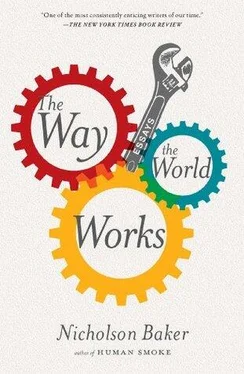Nicholson Baker - The Way the World Works
Здесь есть возможность читать онлайн «Nicholson Baker - The Way the World Works» весь текст электронной книги совершенно бесплатно (целиком полную версию без сокращений). В некоторых случаях можно слушать аудио, скачать через торрент в формате fb2 и присутствует краткое содержание. Год выпуска: 2012, Издательство: Simon & Schuster, Жанр: Публицистика, Критика, на английском языке. Описание произведения, (предисловие) а так же отзывы посетителей доступны на портале библиотеки ЛибКат.
- Название:The Way the World Works
- Автор:
- Издательство:Simon & Schuster
- Жанр:
- Год:2012
- ISBN:нет данных
- Рейтинг книги:4 / 5. Голосов: 1
-
Избранное:Добавить в избранное
- Отзывы:
-
Ваша оценка:
- 80
- 1
- 2
- 3
- 4
- 5
The Way the World Works: краткое содержание, описание и аннотация
Предлагаем к чтению аннотацию, описание, краткое содержание или предисловие (зависит от того, что написал сам автор книги «The Way the World Works»). Если вы не нашли необходимую информацию о книге — напишите в комментариях, мы постараемся отыскать её.
), here assembles his best short pieces from the last fifteen years.
The Way the World Works
OED
Modern Warfare 2
Through all these pieces, many written for
, and
, Baker shines the light of an inexpugnable curiosity.
is a keen-minded, generous-spirited compendium by a modern American master.
The Way the World Works — читать онлайн бесплатно полную книгу (весь текст) целиком
Ниже представлен текст книги, разбитый по страницам. Система сохранения места последней прочитанной страницы, позволяет с удобством читать онлайн бесплатно книгу «The Way the World Works», без необходимости каждый раз заново искать на чём Вы остановились. Поставьте закладку, и сможете в любой момент перейти на страницу, на которой закончили чтение.
Интервал:
Закладка:
“Let Me Greet You Personally At My Restaurant,” said Jack Dempsey, at the bottom of page two, on April 20; in June, Jake LaMotta, fighting as a light heavyweight, was “battered into a sick and gory spectacle” at Yankee Stadium — General MacArthur was in the audience. “Do you ever wish your child were going to a nudist camp?” was Macy’s attention-grabber, promoting its extensive summer-camp outfittery. Two women ran unsuccessfully for seats on the AT&T board — there were “a number of Rip Van Winkles” in the company, according to one stockholder. Automatic ten-number dialing, using area codes, was introduced in New Jersey. Bus stops moved to the far sides of city intersections, and parking meters appeared in Manhattan. The Yonkers Police Department hired ten women to serve as traffic officers at school crossings at a rate of four dollars a day. Ex-King Zog paid for an estate in Syosset with a bucket of diamonds and rubies. The runoff from Long Island duck farms was killing beds of bluepoint oysters. Dashiell Hammett got six months in jail for refusing to reveal who had contributed to a pro-Communist bail-bond fund; “I think I dealt with him in an extremely lenient manner,” said the sentencing judge. When a ring slipped from the finger of the daughter of the governor of Assam, in India, and fell into a lake, the governor had the lake drained in an attempt to recover the ring, causing “a storm of protest.”
Someone stole four thousand ball bearings. There was a surplus of sweet potatoes in New Jersey; the Department of Agriculture was advising housewives to serve them often. An inedible cake in the shape of Winged Victory atop a Roman temple was a prizewinner at the Salon of Culinary Art. Stopping Joseph McCarthy was “the most important single political job that has faced Wisconsin in many years,” said Henry S. Reuss, a Milwaukee lawyer and Democrat who wanted a seat in the Senate. An intentionally soporific phonograph record called “Time to Sleep” was determined to fall within the control of the Pure Food and Drug Act. An ad announced a free home trial of the sensational new Polaroid camera—“Takes and Prints Finished Pictures in One Minute!” Ten cases of major psychiatric illness were observed to follow heavy doses of certain steriods. Roy M. Cohn, the assistant United States attorney, arrested some dealers in “hot tea”—marijuana. Attorney Cohn said that one marine with a distinguished war record “fell into the hands of these people so that his health and his entire life has been ruined”; the accompanying picture showed Police Commissioner Murphy dumping a shovelful of drug packets into the furnace in the basement of the police headquarters annex.
Old newspapers can pull you in deep very quickly. For a little while, as I turned the pages, the headlines and columns expanded and pushed aside all the rest of history — ungeneralizably rich and busy and full of telling confusions. On January 1, 1951, Anne O’Hare McCormick, the foreign affairs columnist, wrote, “News is the destroyer of illusions and the ultimate policy maker.” I found myself agreeing with her.
The newspaper covered its own birthday, of course. On September 18, 1951, the Times, in a forgivable burst of pride, printed dozens of congratulatory messages — President Truman praised the newspaper for its “generally fair and accurate” reporting, the City Council passed a laudatory resolution, the American Polar Society cheered, and Cuba’s Diario de la Marina wrote: “May you continue your brilliant and efficient life as the pride of the American Press.” Even the archrival Herald Tribune paid tribute to the Times ’s “high standards of dignity, thoroughness and accuracy.”
There was more the next day: MESSAGES OF CONGRATULATION CONTINUE POURING IN ON 100TH ANNIVERSARY, reads one headline. The New York Post offered a “warm typewriter toast”: “You would not want us to pretend that we always love you but as Americans and as journalists we can hardly imagine living without you.” Fifty years on, the Post is still right.
(2001)
Take a Look at This Airship!
Introduction to The World on Sunday,
by Nicholson Baker and Margaret Brentano
Joseph Pulitzer, the fretful, sleepless, Hungarian-born genius who, at the close of the nineteenth century, created the modern newspaper, understood Sundays better than most people.
When you got up on Sunday a hundred years ago, in the age of the six-day workweek, and you had a moment to rest and to feel the restlessness that attends rest, what did you want? News? Did you want headlines about Washington and Tammany Hall and Albany? Well, some, but not so much. You definitely wanted a newspaper: you wanted the comfort of a fresh floppy creation that had required the permanent marriage of tankfuls of ink and elephantine rolls of white paper in order to proclaim the elemental but somehow thrilling fact that this very morning in which you found yourself, despite its familiar features, was incontrovertibly, datably, new.
So, yes, you wanted a Sunday newspaper, but what you wanted from it wasn’t really news — it was life. You wanted romance, awe, a close scrape, a prophecy, advice on how to tip or shoplift or gamble, new fashions from Paris, a song to sing, a scissors project for the children, theories about Martians or advanced weaponry, maybe a new job. You wanted to be told over and over again that your city was a city of marvels like no other, but you also wanted to escape for a few minutes to the North Pole or South Dakota or the St. Louis World’s Fair, or to take a boat trip down the Mississippi. You wanted something with many sections that you could dole out to people in the room with you. And you wanted imagery — cartoons, caricatures, “gems of pictorial beauty”—layouts and hand-inked headlines that made your eyeballs bustle and bounce around the department-store display of every page. And that’s what you got when you spent a nickel and bought Joseph Pulitzer’s Sunday World .
The World —the self-described “greatest newspaper on earth”—was actually three newspapers, the morning World (published Monday through Saturday, often with a political cartoon by Walt McDougall or C. G. Bush on the front page), the Evening World (carrying boxing news and sports scores, with a more raffish flavor throughout), and “THE GREAT SUNDAY WORLD,” which weighed as much as a small roast beef. Together these three World s were, in their days of triumph, seen simultaneously by more people than any other publication, with the possible exception of the Bible. Mornings and evenings, hundreds of thousands of fresh World issues groaned out from the basement levels of Pulitzer’s imposingly gold-domed skyscraper onto every New York street corner and trolley stop; in 1899, despite some competition from interloper William Randolph Hearst, the World claimed on its front page, believably, that it had achieved the “largest circulation ever reached in one year by any newspaper.”
The Sunday World was the real prodigy of physical dissemination: it sometimes sold half a million or more copies, and it went all over the country. In 1908 Adolph Ochs, publisher of the smaller, soberer New York Times, wrote admiringly of the World ’s “phenomenal and prodigious success”; another newspaperman, Frank Munsey, said of Pulitzer: “He came here as a whirlwind out of the West, and overturned and routed the conservativism then in vogue as a cyclone sweeps all before it.”
The peculiar thing, however, is that out of all this cyclonic activity, next to nothing survives. Libraries, suspicious of low and pandering art, collected and bound for safekeeping only a few complete original runs of mass-circulation newspapers such as the World —they preferred the New York Times and the Evening Post, papers that carried “real” news with less splash and dash. And then, in the ’50s, intrigued by new techniques of photographic miniaturization, libraries began to replace the few runs of popular papers that they did possess with monochromatic copies made on inch-and-a-half-wide strips of clear plastic: microfilm. (You can see reproductions from a microfilm copy of the Evening World used as wallpaper in many Subway sandwich shops.) Almost every American library that could afford to swapped a new plastic copy for the heavy, space-consuming wood-pulp original — even two of the greatest, the Library of Congress and the New York Public Library. They threw out the bound volumes or, later, sold them to scrap dealers who razored out cartoons, automobile ads, and historical dates, and used the rest as quarry for the “original Newspaper of the Day You Were Born.”
Читать дальшеИнтервал:
Закладка:
Похожие книги на «The Way the World Works»
Представляем Вашему вниманию похожие книги на «The Way the World Works» списком для выбора. Мы отобрали схожую по названию и смыслу литературу в надежде предоставить читателям больше вариантов отыскать новые, интересные, ещё непрочитанные произведения.
Обсуждение, отзывы о книге «The Way the World Works» и просто собственные мнения читателей. Оставьте ваши комментарии, напишите, что Вы думаете о произведении, его смысле или главных героях. Укажите что конкретно понравилось, а что нет, и почему Вы так считаете.












